
Gallery Contents Curator's introduction
Yes Sir, that's my Beaker
You're Late
The situation is grave
All for one
Upwardly mobile
Creeping up...
Beaker Folk, anyone?
I knew it!
List of Displays
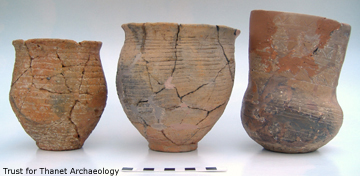
Three Thanet Beakers
Feature scale in 0.1 metre divisions
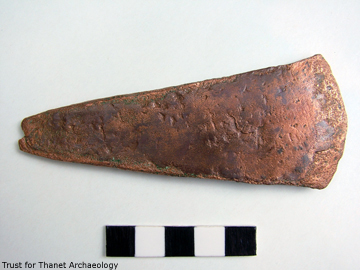
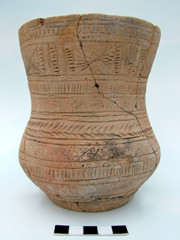
North Foreland Beaker
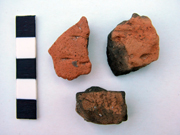
Fingernail-rusticated Beaker sherds from QEQM Margate
In general Beakers were made to a high standard, using local clays. The vessels are frequently thin-walled, intricately decorated and well-fired; distinct in style and quality from the other contemporary Late Neolithic and Early Bronze Age ceramics.
Coarser Beakers also exist and these may have been domestic pots in 'everyday' use. These vessels were also decorated, sometimes with fingernail impressions ('fingernail-rusticated') or simple incised lines.
The quality of manufacture and the decorative form of the best Beakers distinguish them as an innovation that would not be bettered in the later Prehistoric periods, or indeed afterwards!
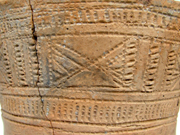
Detail of the North Foreland Beaker
Before the advancements in radiocarbon-dating, researchers had attempted to create a typological ‘timetable’ of the various Beaker styles arranging them in order from ‘Early’ to ‘Late’.
There appear to be significant overlaps between the suggested ‘Early’ and ‘Late’ styles. However these labels are still useful in broadly describing Beaker forms.
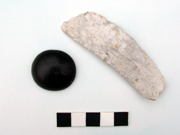
Manston Beaker burial grave goods
Our best evidence of this period generally comes from burials. Complete Beaker pots are primarily found in graves and in this context have been seen as indicators of status.
The Beaker Period saw a revolution in burial traditions, with the practice of interring quality grave-goods and the widespread adoption of the ‘roundbarrow’. These burial monuments generally focused attention on a single individual, unlike the communal tombs favoured previously in the Neolithic.
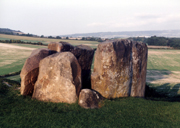
Coldrum Neolithic tomb, Kent
In the Neolithic the dead were generally buried in large communal monuments such as longbarrows and chambered tombs.
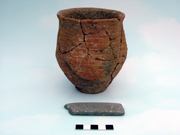
St. Peters Beaker
and stone wristguard
Beakers are sometimes accompanied by other high-status items which also make a first appearance around this time. These include daggers of copper, bronze and flint; barbed and tanged flint arrowheads; jet buttons and belt-sliders; stone wristguards and battle-axes.
The displays of status expressed by Beaker grave-goods show a fundamental change of attitudes in Prehistoric society. They appear to express the elevation and celebration of rich and powerful individuals.
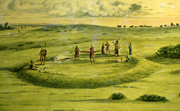
New activity at
Lord of the Manor
Painting by Len Jay
The earliest occurrences of Beaker pottery seem to be confined to the periphery of Neolithic society, first appearing at the long abandoned Earlier Neolithic Causewayed Enclosures and in the final ‘blocking deposits’ in chambered tombs.
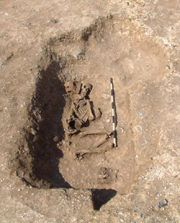
QEQM Margate Beaker burial
Scale in 0.1 metre divisions
Photo by Susan Deacon (TTA)
The appearance of this ‘package’ of new objects and traditions was once seen as evidence of a migration of a new people to Britain – ‘the Beaker Folk’
Archaeological developments previously seen as
innovations of the 'Beaker Folk', such as roundbarrows and single inhumations, as well as some of the
forms of decoration seen on the vessels, have
an indigenous ancestry that precedes the Beaker Period.
There was no doubt some
migration into Britain at this time, but the artefacts probably
represent a movement of new ideas, technologies and cultural
influences, rather than a large incomming population.
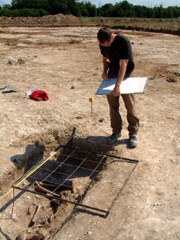
Recording the Beaker burial at QEQM Margate
Photo by Susan Deacon (TTA)
Having said that, the spectacular Beaker burial of the Amesbury Archer (discovered near
New techniques used to
analyse isotopes
of oxygen, absorbed during
childhood and preserved
in teeth, allow
us to broadly locate where some of our ancestors may have been born and
where they may have lived and traveled in their lifetime.
We may even have to revise our revised theories of the Beaker Folk!
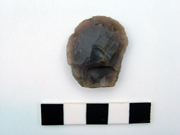
Beaker period flint 'Thumb' scraper
A close-up view of some of the artefacts recovered from Beaker burials on Thanet.
Display 2: Beaker burials on Thanet - Part 1
A Gazetter of known and possible Beaker burials on Thanet.
Display 3: Beaker burials on Thanet - Part 2
An overview of the Beaker heritage of the Isle of Thanet.
Display 4: Radiocarbon-dates from Beaker
burials on Thanet
Pictures of Thanet Beakers with associated radiocarbon-dates presented in descending date order.
TTA - Trust for Thanet Archaeology.
Bibliography
Darvill T. 1987. Prehistoric Britain. Routledge.
Jay L. 1995. Thanet Beakers. Trust for Thanet Archaeology.
Version 1 - Posted 23.03.06
Version 2 - Posted 07.04.06
Version 3 - Posted 21.06.06
Version 4 - Posted 21.10.06
Version 5 - Posted 16.12.06